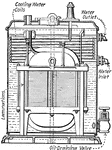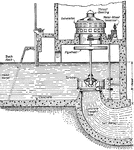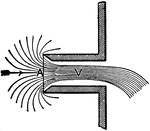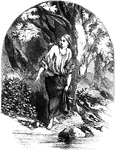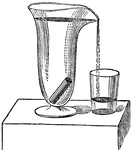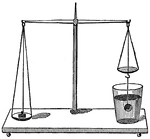
Paris Gargoyle
This illustration shows a Paris Gargoyle in France. Gargoyles, in Gothic architecture, are spouts projecting…

Lincoln Gargoyle
This illustration shows a Lincoln Gargoyle. Gargoyles (featured primarily in in Gothic architecture)…
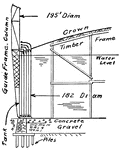
Partial Section of Typical Large American Gas Holder
A gas holder is a metallic shell which is open at the bottom (like a bell), the lower edge of which…

Gills (worm)
This illustration shows a transverse section of a worm with external gills. Gills are the breathing…

Gills (Branchial Arch of Perch)
This illustration shows the gills (breathing apparatus) of a perch, as well as the specific veins and…

Gills (Crayfish)
This illustration shows the thorax of a crayfish with a portion of the carapace removed to show the…
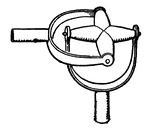
Gimbals (Joint)
A gimbals is a contrivance designed to keep a marine compass, chronometer, lamp, or other instrument…
Rollers (Glue)
This illustration shows liquid in glue manufacturing being carried on rollers, cooled with cold water,…

Chlorination Barrel
The chlorination process in gold extraction employs large vats or revolving barrels, the material inside…

Chlorination Barrel (End Section)
The chlorination process in gold extraction employs large vats or revolving barrels, the material inside…
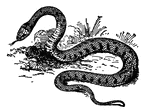
Grass Snake
Its color is olive-gray or brown above, with black bands and spots, and checkered black and white beneath.…
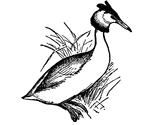
Great Crested Grebe
The Great Crested Grebe (Lophæthyia cristata) is a fresh-water, migratory, diving bird of the family…

Juncus Acutiflorus
Juncus acutiflorus belongs to a genus of grass-like herbs (Juncus) that grow in boggy places.

Juncus Glaucus
Juncus glaucus belongs to a genus of grass-like herbs (Juncus) that grow in boggy places.
Juncus Conglomeratus
Juncus conglomeratus, also known as the common rush, belongs to a genus of grass-like herbs (Juncus)…

Juncus Compressus
Juncus compressus belongs to a genus of grass-like herbs (Juncus) that grow in boggy places.

Juncus Effusus
Known as the soft rush, Juncus effusus is nearly as common as the most common species, J. conglomeratus.…
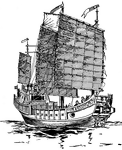
Chinese Junk
A Junk is a native Chinese vessel. It is a clumsy craft, with very high forecastle and poop, and pole…

Softening Process in the Manufacturing of Jute
In the manufacturing of jute, the jute fiber must first be softened. The softening machine consists…

Land Crab
The land crab is a member of the family 'Gecarcinidae', and is remarkable for the curious modification…
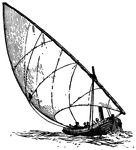
Boat with Lateen-sail
A lateen-sail is a triangular sail extended on a yard which is slung one quarter from the lower end…
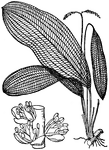
Lattice Leaf
Lattice Leaf is the popular name of a water plant, 'Aponogeton jenestralis', belonging to the order…
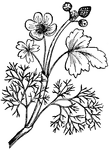
Water Crowfoot
This illustration shows a water crowfoot, with broad, floating leaves, and much-cut, submerged leaves.

Medicinal Leech
The medicinal leech is a leech used in bloodletting. It lives in fresh water, and is common in Germany,…

Lemming
A lemming is a small, yellowish-brown rodent, closely related to the vole, and belonging to the genus…

The Lentil Plant
This illustration shows a lentil plant. Lentils are the round, flat seeds of a small leguminous plant…
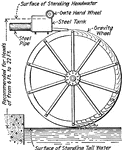
Waterwheel
A gravity-type waterwheel, the most efficient wheel for very low heads and small quantities of water.

Reaction Wheel
Illustrating the principle of the reaction wheel. (Shows a cylinder-gate, horizontal-type turbine mounted…

Egyptian Agriculture
An example of Egyptian agriculture. 1, the reapers; 2, reaper drinking from cup; 3, 4, Gleaners - the…

Rappahannock River
American soldiers retreating across the Rappahannock river in Northwest Virginia. It shows an example…
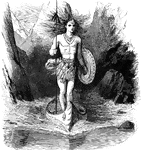
Young Brave
A young man standing in a canoe holding a spear and a shield against a mountainous background.
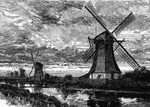
Windmills along a Canal
Windmills stand along a canal. The are probably polder mills used to move water up and out of lowlands,…

Hinds Chain Cultivator
A Hinds chain cultivator that is used for tillage and drawing fallen squares to water furrow.
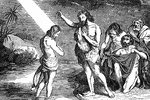
Baptism of Jesus by John
"Then cometh Jesus from Galilee to the Jordan unto John, to be baptized of him. But John would have…

Jesus Cures an Epileptic Boy
"And when they were come to the multitude, there came to him a man, kneeling to him, saying, Lord, have…

Scourging of Jesus
"So when Pilate saw that he prevailed nothing, but rather that a tumult was arising, he took water,…
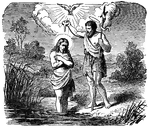
The Baptism of Jesus by John the Baptist in the Jordan River
"And it came to pass in those days, that Jesus came from Nazareth of Galilee, and was baptized of John…
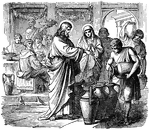
Jesus Turns Water into Wine at the Wedding at Cana
"Jesus saith unto them, Fill the waterpots with water. And they filled them up to the brim. And he saith…
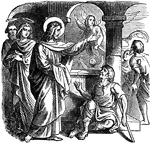
Jesus Heals a Sick Man at the Pool of Bethesda
"Jesus saith unto him, Arise, take up thy bed, and walk. And straightway the man was made whole, and…
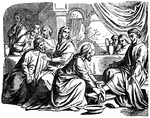
Jesus Washes the Feet of His Twelve Disciples after the Last Supper
"Then he poureth water into the basin, and began to wash the disciples' feet, and to wipe them with…
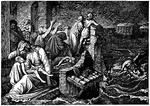
The Deluge - Noah's Ark Floats into the Rising Flood Waters as People Trapped on Land Watch in Horror
"And every living thing was destroyed that was upon the face of the ground, both man, and cattle, and…
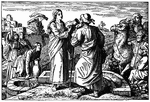
Rebecca Offers Water to Eliezer at the Well and is Chosen to be Isaac's Wife
"And let it come to pass, that the damsel to whom I shall say, Let down thy pitcher, I pray thee, that…
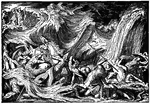
The Red Sea Swallows Pharaoh and His Army
"And Moses stretched forth his hand over the sea, and the sea returned to its strength when the morning…
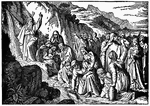
Moses Strikes the Rock and Water Flows in the Desert
"Behold, I will stand before thee there upon the rock in Horeb; and thou shalt smite the rock, and there…

Elijah Hides from Ahab and is Fed by Angels and Ravens
"So he went and did according unto the word of Jehovah; for he went and dwelt by the brook Cherith,…
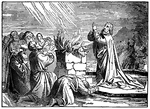
Elijah Praying to God to Set Fire to His Altar in Front of the Prophets of Baal
"Then the fire of Jehovah fell, and consumed the burnt-offering, and the wood, and the stones, and the…
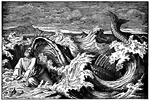
Jonah is Swallowed by a Great Fish Sent by God
"And Jehovah prepared a great fish to swallow up Jonah; and Jonah was in the belly of the fish three…

